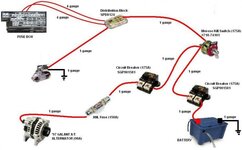Kai Hefner
Freelancer
- 480
- 272
- Jun 21, 2018
-
Calgary,
AB_Canada
Going to upgrade my alternator wire for a rewound 110A alternator tomorrow. I'm under the impression that all I have to do in terms of wiring upgrades is to add some 4 gauge welding wire on top of the old alternator wires.
I was wondering, could I route my new wire straight to the battery instead of to the fuse box then to the battery?
How much wire do I need?
I was wondering, could I route my new wire straight to the battery instead of to the fuse box then to the battery?
How much wire do I need?

















